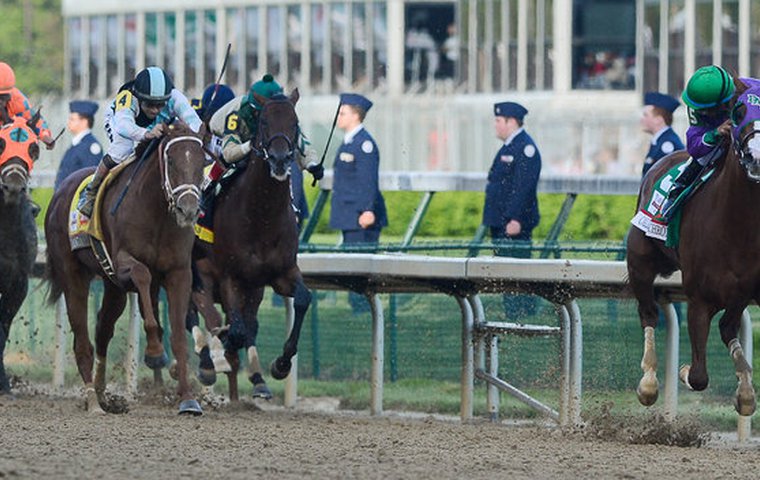
Despite California Chrome’s relatively poor Beyer figure in Saturday’s Kentucky Derby, race analyst James Willoughby reckons the colt will prove his worth in the Preakness Stakes on May 17. However, the Belmont Stakes on June 7 may be another matter.
California Chrome’s Kentucky Derby win confirmed he is a fast horse in a slow era. In the same way that Major League Baseball sluggers don’t hit 50 home runs any more, America’s top Thoroughbreds don’t touch two minutes for the 10 furlongs of America’s favourite race.
It is common to see baseball teams wear retro uniforms nowadays, recalling an era of the sport that was only previously seen in sepia tone. For his part, California Chrome rolled back the years by running a slower time than Old Rosebud back in 1914.
It beggars belief that a Kentucky Derby winner could run 2 minutes, 3.66 seconds on a track labelled “fast.” Moreover, to do so while coming home in 26.21 seconds, with his jockey easing down, seems a deeply unflattering reflection of the standard of the modern U.S. Triple Crown.
This was the theme of Andrew Beyer’s column in the Washington Post. He refers to the winner’s race-winning move off the home turn as “an illusion” and relates that the speed figure California Chrome earned was the lowest ever for a Derby or Preakness.
On the face of it, the historically slow time seems to confirm the premise of my analysis of the negative trend of Derby times before the race. And, indeed, it is now becoming increasingly likely that, at least over 10 furlongs or more, American 3-year-olds struggle to see the race out well enough to post similar times to their illustrious forebears. At least the impressive Kentucky Oaks winner Untapable did her bit to show this isn’t the case over shorter distances, covering the nine furlongs of her Classic faster than every other triumphant filly since 2003.
In my opinion, however, California Chrome and his pursuers are not quite as slow as the numbers suggest. According to some reports, the track was watered some time before the Derby got underway on a warm, windy day and it may well have been running a little slow. I am inclined to believe that California Chrome’s true ability is better represented by his pre-race Beyer numbers of 108 and 107 than the figure of 97 he achieved in the race. Then again, his better efforts did come over shorter distances on a speed-favouring Santa Anita surface.
Either way, this handicapper believes that California Chrome will produce a number to legitimise his status in the Preakness Stakes on May 17. The Pimlico Race Course circuit presents a test of speed and cutting back half a furlong in distance will help. The Art Sherman-trained colt will take all the beating there, but it seems most unlikely that he will see out a mile and a half in the Belmont Stakes sufficiently well, even if nothing else truly does either.
If the current trend of Triple Crown times persists, there may be a perverse result for racing. In any competitive environment, it is easier to excel if the bar is low than if there are many elite performers clustered around a theoretical maximum. In other words, if the fastest horse also stays reasonably well, it makes it more likely he will complete the Crown. And the 15 horses to have won at least two legs since Affirmed’s 1978 sweep suggest the feat is not unfeasible.
One wonders, however, if it would be better for the potential windfall of a Triple Crown winner to be delayed. At present, the sport is in such turmoil over the pervasive influence of performance enhancing drugs that negative associations could subsume some of the romance a Triple Crown winner provokes. Would itinerant viewers of the sport merely reflect that the winning trainer has the most powerful “juice,” however unfair that may be? Is it possible for the fan to meld the wonderment of watching the great galloping athlete with the fear that the denouement might be akin to that of the little boy – “Say it ain’t so, Joe” – in “Eight Men Out,” the 1988 film narrating the Black Sox scandal that tainted the 1919 World Series in baseball.
In 1955, when Chrome’s trainer Sherman was an attendant of another California king, Swaps, the Kentucky Derby served up the kind of race that you can still watch now and feel shivers down the spine: Swaps versus Nashua, Shoemaker versus Arcaro, the upstart West versus established East. Abstracted from the licentiousness that now surrounds it, top-class racing on dirt is still capable of races that make you feel lucky to have ever found the sport as a fan.
Personally, I remain a believer in California Chrome – but – not as a Triple Crown winner. I don’t see how he can possibly thrive on the deeper, sandy surface at Belmont Park over a mile and a half, when he can’t beat 26 seconds for the last quarter of the Derby. Something will beat him; perhaps even something behind him at Churchill Downs, such as Danza or Wicked Strong, freshened after skipping the Preakness.
Either way, I hope there is an impressive Belmont winner, a horse capable of disguising the depths to which the American Classic horse has fallen. In the Derby, the lustre of Chrome distracted many from the grime underneath.

